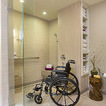Solving aging in place issues during an elder construction project will soon become the number one challenge concerning the present obsolete housing inventory in our country. Our present day obsolete homes now inhabited by the baby boomer generation will slowly and increasingly raise their outdated and obsolete ugly heads and expose their true lack of accessibility to those very people inhabiting them. The situation will only become ever more expanding in time. When these homes were previously purchased, they represented an absolute castle in the world of their owners in which to prepare for a day and they also acted as a retreat from life's tough interactions. They housed our families, our memories, and our stuff. They represented a place where we could be ourselves. Our homes have always been exempt from any and all of the accessibility regulations that have been put in place since 1968 when our Viet Nam veterans were returning home. Even the ADA Act of 1991 never affected our homes but it did accomplish getting us into our work places and entertainment environments more safely.
Aging in place design and CAPS certified remodeling in Austin, Texas will be completely driven by the homeowner's desire to remain in their home for as long as it is physically possible. When disability strikes, that same home you have endeared for at least part of your lifetime can become a prison that presents barriers, frustrations, and perils at every turn. This is when aging in place services come into play. The lack of any preparation or access upgrades possibly is driven by our youth oriented culture that wants to believe we are all young, bullet proof, and fit and will continue to be so. Perhaps we believe as a society that accessible upgrades will decrease our home's property values. The contrary is the reality. Just try looking for a barrier free accessible home. Actually, don't even bother. There are none. Oh yes, there are retirement communities for the older "active" seniors but the key word here is active having nothing to do with accessibility.
Disability is a complex phenomenon representing an interaction between one's physical impairments, the activities they need to perform, and the architectural barriers within the space in which this situation occurs. The terminology and jargon used for disabilities evolves regularly whereas, "handicapped" is no longer acceptable. It is no longer merely a description of intellectual or physical impairments. Each individual with similar impairments describes his or her limitations differently. The blind don't experience their world the same as a person with deafness and so on.
There are really three categories of aging in place customers. Those who are simply and wisely planning ahead for their futures to remain in their present homes retrofitting their homes with elder living solutions. The second category concerns those people who know they have a chronic medical disorder and need to prepare in advance for accessibility issues which will come as a result of their disease. People with diseases that are constantly causing increased physical or mental changes to their being are a good representative of this second group. The third group involves those people who either have had a chronic problem that has progressed severely altering their mobility or those who have sustained a life altering tragedy such as being involved in an accident. All of these groups will drive the future metamorphosis of existing inaccessible dwellings.
Let's face it, accessible homes are needed by all of us at some time in our lives. This is true whether it's for ourselves, a family member, or a guest. The need is certainly not driven by age but is a result of life's experience. Any family living with disability among any of it's generations within it's group can always benefit from additional accessibility. This will in turn increase safety and independence for all involved as they go through life.
If you are considering an aging in place remodel for your home don't just contact any local remodeler in your area and expect a satisfactory accessible home modification. A professional design/build accessibility project can only be created for your specific needs by a qualified home remodeler having a nationally accepted CAPS certification. This credential is backed by the NAHB. Only a CAPS home remodeler possesses the specific knowledge that will insure a successful outcome for your aging in place project and what's more, keep you in your home.
Aging In Place Home Modifications














